The efficiency and smooth running of any workshop comes down to one thing – a clear, well-organised booking diary.
Whether it’s on the computer, a whiteboard or an old-fashioned (but reliable) paper ledger, any booking diary is only as good as the information you put in it.
Get it right (and be rigorous about how you run it) and everything will flow beautifully.
Think of your booking diary as a planning diary
We’ve created a list of 18 sections every good booking diary must have. We’ve also got a free editable template for you to download and use.
This isn’t any ordinary booking diary. This is a planning diary, based on the experiences and advice of our members.
How is it different? It doesn’t include just basic booking information but adds columns covering job planning and job progression. It’s designed to maximise efficiency within your workshop.
So, what’s in it?
The ‘booking’ section
The planning diary is broken into three sections. The booking section is fairly self-explanatory and includes all the information gathered when taking a booking.
Here are the seven columns we suggest including:
- Customer name
- Phone number
- Vehicle model
- Job requirements
- Vehicle rego (so vehicle history can be retrieved prior to customer arrival)
- Drop off time (to help with your daily planning)
- Courtesy car required (if you offer it).
The ‘job preparation’ section
This section of the planning diary should include the routines that must be followed prior to the customer’s arrival.
These are the three columns we suggest including:
- Parts ordered (do parts need to be ordered in preparation? Have they been ordered?)
- Parts received (have the ordered parts been received?)
- Job card prepared (has a job card been prepared?)
The ‘job progression’ section
The final section of the planning diary should include the administration routines that need to be carried out for every customer.
Here are eight columns we suggest including:
- Car arrival time
- Time required (when does the customer need the vehicle?)
- Tech allocated (which technician has been allocated to the job?)
- Progress call (has the customer been called for an update on job status, including authorisation for the repairs?)
- Called for pick up (has the customer been told that their vehicle is ready for collection?)
- Invoiced (has the invoice been prepared?)
- Picked up (has the vehicle been picked up?)
- Overnight (is the vehicle staying overnight?)
Download your free editable workshop planning diary
The planning diary is designed to be printed on an A3 size sheet, to allow plenty of space for you to write in the information.
You may have some changes or improvements to suit the way your workshop operates. If so, make those changes. This is all about you creating the most efficient and smooth-running workshop possible!
You can download your free planning diary template here.

